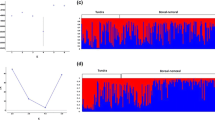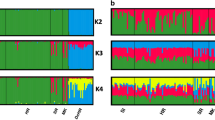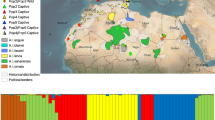Abstract
Fur-animal farms can affect the genetic constitution of wild conspecifics through escape and subsequent interbreeding. We studied this problem in red foxes (Vulpes vulpes) on the Canadian island of Newfoundland, where a large commercial fox farm (the only large farm on the island) has operated adjacent to the native wild red fox population for >30 years. To test for gene flow from these fur-farm foxes into the wild population, we compared mitochondrial DNA (mtDNA) sequences and nuclear microsatellite genotypes (21 loci) of 93 individuals from the fox farm to those of 79 modern wild foxes sampled from across the island. For reference, we also included 12 historical museum specimens of wild eastern Canadian red fox, all of which were sampled before the introduction of fur farming in the region. Many mtDNA haplotypes were shared among contemporary farmed and wild foxes and the historical eastern Canadian samples, as expected based on the eastern Canadian origin of fur-farming. However, only the fur farm additionally contained haplotypes originating from other parts of North America. More significantly, microsatellite markers, which reflect contemporary gene flow, indicated strong differentiation (F ST ≥ 0.14, P < 0.001) between fur-farm and wild foxes (including the historical samples) and little to no gene flow between them. Admixture and principle components analyses similarly supported clear separation of fur-farm and wild red foxes. Together, these findings indicate that the presence of a large red fox fur farm had little, if any, effect on the genetic constitution of the native wild population in Newfoundland. Tight biosecurity (lack of escapees) or failure of captive-reared foxes to establish in the presence of native wild foxes could explain these findings.




Similar content being viewed by others
References
Allendorf FW, Leary RF, Spruell P, Wenburg JK (2001) The problems with hybrids: setting conservation guidelines. Trends Ecol Evol 16:613–622
Altschul SF, Gish W, Miller W, Myers EW, Lipman DJ (1990) Basic local alignment search tool. J Mol Biol 215:403–410
Anonymous (1917) Newfoundland Fur Industry. J R Soc Arts 65:483–484
Aubry K (1984) The recent history and present distribution of the red fox in Washington
Aubry KB, Statham MJ, Sacks BN, Perrine JD, Wisely SM (2009) Phylogeography of the North American red fox: vicariance in Pleistocene forest refugia. Mol Ecol 18:2668–2686
Balcom A (1916) Fox farming in Prince Edward Island: a chapter in the history of speculation. Q J Econ 30:665–681
Beauclerc KB, Bowman J, Schulte-Hostedde AI (2013) Assessing the cryptic invasion of a domestic conspecific: American mink in their native range. Ecol Evol 3:2296–2309
Bennett SN, Olson JR, Kershner JL, Corbett P (2010) Propagule pressure and stream characteristics influence introgression: cutthroat and rainbow trout in British Columbia. Ecol Appl 20:263–277
Bourret V, O’reilly P, Carr J, Berg P, Bernatchez L (2011) Temporal change in genetic integrity suggests loss of local adaptation in a wild Atlantic salmon (Salmo salar) population following introgression by farmed escapees. Heredity 106:500–510
Carter J, Leonard BP (2002) A review of the literature on the worldwide distribution, spread of, and efforts to eradicate the coypu (Myocastor coypus). Wildl Soc Bull 30:162–175
Champagnon J, Elmberg J, Guillemain M, Gauthier-Clerc M, Lebreton J-D (2012) Conspecifics can be aliens too: a review of effects of restocking practices in vertebrates. J Nat Conserv 20:231–241
Denisov GA, Arehart AB, Curtin MD (2004) A system and method for improving the accuracy of DNA sequencing and error probability estimation through application of a mathematical model to the analysis of electropherograms. US Patent 6681186
Earl DA, vonHoldt BM (2012) STRUCTURE HARVESTER: a website and program for visualizing STRUCTURE output and implementing the Evanno method. Conserv Genet Res 4:359–361
Evanno G, Regnaut S, Goudet J (2005) Detecting the number of clusters of individuals using the software structure: a simulation study. Mol Ecol 14:2611–2620
Excoffier L, Lischer HE (2010) Arlequin suite ver 3.5: a new series of programs to perform population genetics analyses under Linux and Windows. Mol Ecol Res 10:564–567
Falush D, Stephens M, Pritchard JK (2003) Inference of population structure: extensions to linked loci and correlated allele frequencies. Genetics 164:1567–1587
Gering E, Johnsson M, Willis P, Getty T, Wright D (2015) Mixed ancestry and admixture in Kauai’s feral chickens: invasion of domestic genes into ancient Red Junglefowl reservoirs. Mol Ecol 24:2112–2124
Gil-Sánchez J, Jaramillo J, Barea-Azcón J (2015) Strong spatial segregation between wildcats and domestic cats may explain low hybridization rates on the Iberian Peninsula. Zoology 118:377–385
Goedbloed D, Megens H, Van Hooft P, Herrero-Medrano J, Lutz W, Alexandri P, Crooijmans R, Groenen M, Van Wieren S, Ydenberg R (2013) Genome-wide single nucleotide polymorphism analysis reveals recent genetic introgression from domestic pigs into Northwest European wild boar populations. Mol Ecol 22:856–866
Hall TA (1999) BioEdit: a user-friendly biological sequence alignment editor and analysis program for Windows 95/98/NT. Nucleic Acids Symp Ser 41:95–98
Hammershøj M, Pertoldi C, Asferg T, Møller TB, Kristensen NB (2005) Danish free-ranging mink populations consist mainly of farm animals: evidence from microsatellite and stable isotope analyses. J Nat Conserv 13:267–274
Jeffery RA, Lankester MW, McGrath MJ, Whitney HG (2004) Angiostrongylus vasorum and Crenosoma vulpis in red foxes (Vulpes vulpes) in Newfoundland, Canada. Can J Zool 82:66–74
Jombart T (2008) adegenet: a R package for the multivariate analysis of genetic markers. Bioinformatics 24:1403–1405
Kasprowicz AE, Statham MJ, Sacks BN (2016) Fate of the other redcoat: remnants of colonial British foxes in the Eastern United States. J Mammal 97:298–309
Kauhala K, Kowalczyk R (2011) Invasion of the raccoon dog Nyctereutes procyonoides in Europe: history of colonization, features behind its success, and threats to native fauna. Curr Zool 57:584–598
Kidd A, Bowman J, Lesbarreres D, Schulte-Hostedded A (2009) Hybridization between escaped domestic and wild American mink (Neovison vison). Mol Ecol 18:1175–1186
Laikre L, Schwartz MK, Waples RS, Ryman N (2010) Compromising genetic diversity in the wild: unmonitored large-scale release of plants and animals. Trends Ecol Evol 25:520–529
Langille BL, O’Leary KE, Whitney HG, Marshall HD (2014) Mitochondrial DNA diversity and phylogeography of insular Newfoundland red foxes (Vulpes vulpes deletrix). J Mammal 95:772–780
Laut AC (1921) The fur trade of America. Macmillan, New York
Le Roux JJ, Foxcroft LC, Herbst M, MacFadyen S (2015) Genetic analysis shows low levels of hybridization between African wildcats (Felis silvestris lybica) and domestic cats (F. s. catus) in South Africa. Ecol Evol 5:288–299
Lewis JC, Sallee KL, Golightly RT (1993) Introduced red fox in California. State of California, the Resources Agency, Department of Fish and Game, Wildlife Management Division
Mager KH, Colson KE, Hundertmark KJ (2013) High genetic connectivity and introgression from domestic reindeer characterize northern Alaska caribou herds. Conserv Genet 14:1111–1123
McGinnity P, Prodöhl P, Ferguson A, Hynes R, ó Maoiléidigh N, Baker N, Cotter D, O’Hea B, Cooke D, Rogan G (2003) Fitness reduction and potential extinction of wild populations of Atlantic salmon, salmo salar, as a result of interactions with escaped farm salmon. Proc R Soc Lond B 270:2443–2450
Moore M, Brown S, Sacks B (2010) Thirty-one short red fox (Vulpes vulpes) microsatellite markers. Mol Ecol Res 10:404–408
Noren K, Dalen L, Kvaløy K, Angerbjörn A (2005) Detection of farm fox and hybrid genotypes among wild arctic foxes in Scandinavia. Conserv Genet 6:885–894
Paradis E (2010) pegas: an R package for population genetics with an integrated–modular approach. Bioinformatics 26:419–420
Perrine JD, Pollinger JP, Sacks BN, Barrett RH, Wayne RK (2007) Genetic evidence for the persistence of the critically endangered Sierra Nevada red fox in California. Conserv Genet 8:1083–1095
Petersen M (1914) The fur traders and fur bearing animals. Hammond Press, Pittsburg
Pritchard JK, Stephens M, Donnelly P (2000) Inference of population structure using multilocus genotype data. Genetics 155:945–959
Randi E (2008) Detecting hybridization between wild species and their domesticated relatives. Mol Ecol 17:285–293
Rhymer JM, Simberloff D (1996) Extinction by hybridization and introgression. Annu Rev Ecol Syst 27:83–109
Robertson A, Hill WG (1984) Deviations from Hardy-Weinberg proportions: sampling variances and use in estimation of inbreeding coefficients. Genetics 107:703–718
Sacks BN, Statham MJ, Perrine JD, Wisely SM, Aubry KB (2010) North American montane red foxes: expansion, fragmentation, and the origin of the Sacramento Valley red fox. Conserv Genet 11:1523–1539
Sacks BN, Moore M, Statham MJ, Wittmer HU (2011) A restricted hybrid zone between native and introduced red fox (Vulpes vulpes) populations suggests reproductive barriers and competitive exclusion. Mol Ecol 20:326–341
Sacks BN, Brazeal JL, Lewis JC (2016) Landscape genetics of the nonnative red fox of California. Ecol Evol 6:4775–4791
Statham MJ, Trut LN, Sacks BN, Kharlamova AV, Oskina IN, Gulevich RG, Johnson JL, Temnykh SV, Acland GM, Kukekova AV (2011) On the origin of a domesticated species: identifying the parent population of Russian silver foxes (Vulpes vulpes). Biol J Linn Soc 103:168–175
Statham MJ, Sacks BN, Aubry KB, Perrine JD, Wisely SM (2012) The origin of recently established red fox populations in the United States: translocations or natural range expansions? J Mammal 93:52–65
Statham MJ, Murdoch J, Janecka J, Aubry KB, Edwards CJ, Soulsbury CD, Berry O, Wang Z, Harrison D, Pearch M, Tomsett L (2014) Range-wide multilocus phylogeography of the red fox reveals ancient continental divergence, minimal genomic exchange and distinct demographic histories. Mol Ecol 23:4813–4830
Stronen AV, Paquet PC (2013) Perspectives on the conservation of wild hybrids. Biol Conserv 167:390–395
Tamura K, Stecher G, Peterson D, Filipski A, Kumar S (2013) MEGA6: molecular evolutionary genetics analysis version 6.0. Mol Biol Evol 30:2725–2729
Toonen RJ, Hughes S (2001) Increased throughput for fragment analysis on an ABI Prism® 377 automated sequencer using a membrane comb and STRand software. Biotechniques 31:1320–1325
Volkmann LA, Statham MJ, Mooers AØ, Sacks BN (2015) Genetic distinctiveness of red foxes in the Intermountain West as revealed through expanded mitochondrial sequencing. J Mammal 96:297–307
Wandeler P, Funk S (2006) Short microsatellite DNA markers for the red fox (Vulpes vulpes). Mol Ecol Notes 6:98–100
Wisely SM, Madonado JE, Fleischer RC (2004) A technique for sampling ancient DNA that minimizes damage to museum specimens. Conserv Genet 5:105–107
Wolf DE, Takebayashi N, Rieseberg LH (2001) Predicting the risk of extinction through hybridization. Conserv Biol 15:1039–1105
Acknowledgements
We thank Siobhan Aamoth for assistance with laboratory procedures. Support for this research was provided by the Mammalian Ecology and Conservation Unit at the University of California, Davis. We thank M & E Weisman and many Newfoundland trappers for contributing genetic samples for this project.
Author information
Authors and Affiliations
Corresponding author
Electronic supplementary material
Below is the link to the electronic supplementary material.
Rights and permissions
About this article
Cite this article
Lounsberry, Z.T., Quinn, C.B., Statham, M.J. et al. Investigating genetic introgression from farmed red foxes into the wild population in Newfoundland, Canada. Conserv Genet 18, 383–392 (2017). https://doi.org/10.1007/s10592-016-0914-6
Received:
Accepted:
Published:
Issue Date:
DOI: https://doi.org/10.1007/s10592-016-0914-6




